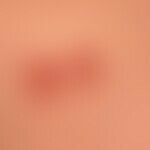Synonym(s)
HistoryThis section has been translated automatically.
Laugier and Woringer 1963; Mehregan et al. 1967.
DefinitionThis section has been translated automatically.
Rare chronic skin disease characterized by transepidermal elimination of collagen and/or elastin through the skin. In the acquired (acquired collagenosis) form occurring in adults, it is often associated with diabetes mellitus and/or chronic terminal renal insufficiency.
Basically, there are 2 clinical syndromes:
- The much more frequent acquired reactive collagenosisin adults, which occurs mainly in diabetics and patients with renal insufficiency (incidences of up to 11% have been described). Acquired reactive collagenosis has also been described in patients with acute myeloid leukemia and after treatment with sorafenib.
- The very rare familial (primarily described as reactive perforating collagenosis), focal connective tissue degeneration with transepithelial shedding of collagen fibers, which already occurs in children. It can be assumed that this genodermatosis is identical to the"hyperkeratosis follicularis et parafollicularis in cutem penetrans" described by Kyrle.
You might also be interested in
EtiopathogenesisThis section has been translated automatically.
1) Genodermatosis with unexplained etiopathogenesis.
2) Acquired in underlying diseases such as chronic terminal renal failure or diabetes mellitus. In isolated cases, the association with malignancies - prostate carcinoma, chronic lymphocytic leukemia - has been described (Huseynova L et al 2020).
3) Drug induced (e.g. by sorafenib - Vega Díez D et al. 2020).
The clinical picture has also been described in scabies and zoster, although the triggering of the disease in these cases is more likely to be reactive as a "Köbner phenomenon" with a corresponding disposition, or as an isotopic reaction.
Remark: probably as a result of mechanical or inflammatory irritation in receptive skin, there is focal damage to the collagenous connective tissue of the skin (scratching can experimentally induce RPK - Köbner phenomenon), which is finally discharged transepidermally.
Proteolytic enzymes such as matrix metalloproteases or serine proteases as well as modifications of sugar side chains on extracellular matrix proteins such as collagen I and III play an important role.
ManifestationThis section has been translated automatically.
In classic reactive perforating collagenosis, the mean age of onset is 50-60 years. The average duration of disease is 8 months.
LocalizationThis section has been translated automatically.
Mainly extensor sides of the extremities and the trunk. The face, palms of hands and soles of feet remain free of symptoms, as do the mucous membranes.
ClinicThis section has been translated automatically.
There is moderate to marked (non-histaminergic) pruritus.
Clinically, there are usually symmetrically distributed, few to numerous, disseminated or linearly grouped ( Köbner phenomenon), red, firm papules or plaques with central ulceration and hard, firmly adherent keratotic plug, initially about 0.2 cm in size, gradually increasing to 1.0 -2.0 cm in size.
Typically, there is evidence of a central crusty defect already in initial papules. After its detachment, an ulcerated crater is found, which heals spontaneously with hyperpigmentation after 2-4 weeks.
Remark: Although a rare disease, the clinical picture is unique and therefore unmistakable, so that the diagnosis is relatively easy to make if the clinical picture is known.
HistologyThis section has been translated automatically.
Hyperplastic epidermis with central bowl-shaped exulceration. In the material stored here, there are horny masses, granulation tissue with triggered, basophilic, collagenous fiber bundles (TOE stain). In the underlying dermis, a nonspecific mixed inflammatory infiltrate is seen.
Differential diagnosisThis section has been translated automatically.
Prurigo simplex subacuta (most important differential diagnosis); no causative underlying disease. Eminently severe itching of the scratched papules.
Prurigo nodularis (see below Prurigo chronic).
Rare differential diagnoses:
- Elastosis perforans serpiginosa (anular grouped papules with adherent keratoses).
- perforating granuloma anulare (skin-colored bifurcated papules)
- calcinosis cutis (rock-hard, pointed calcifications)
- Hyperkeratosis follicularis et parafollicularis in cutem penetrans (predominantly localized on the legs)
- Ecthyma (V.a. lower leg)
TherapyThis section has been translated automatically.
A causal therapy is otherwise not known. In the acquired forms, the treatment of the underlying disease is in the foreground (especially diabetes control!).
Externa: Highly potent corticoid externa or external retinoid (the sympt. Therapy with highly potent corticosteroids (also over large areas) has proved successful in our own experience and in the experience of some authors. Injections with depot steroids every 3 weeks are a good alternative, especially in areas of the back that are difficult to reach with cream.
Try PUVA therapy.
Alternative: Good experiences have been made with systemically administered allopurinol (100 mg/day/p.o.). The mechanism of action is unclear. It is possible that the inhibition of xanthine oxidase and an antioxidant effect inhibit the cross-linking of collagen fibers.
Alternative: Recently, several publications have been published describing good clinical results with dupilumab (Gil-Lianes J et al. 2022; Ying Y et al. 2022 )
Care: in addition to consistent skin care, it is advisable to cover the areas with a hydrocolloid plaster (dissolves the central plug, promotes healing, prevents scratching).
Progression/forecastThis section has been translated automatically.
The acquired form of perforating collagenosis is known to have a relapsing course. There is a not inconsiderable tendency to heal spontaneously. It is important to treat the underlying disease (e.g. precise control of diabetes mellitus).
Note(s)This section has been translated automatically.
Perforations of the skin (perforating dermatoses) are found as a secondary phenomenon in a larger number of diseases.
For example: calcinosis cutis, foreign body granulomas, gout, chondrodermatitis nodularis chronica helicis, granuloma anulare, sarcoidosis, necrobiosis lipoidica, malignant melanoma, T-cell lymphoma, Paget's disease, Kyrle 's disease and others.
LiteratureThis section has been translated automatically.
- Fretzin DF, Beal DW, Jao W (1980) Light and ultrastructural study of reactive perforating collagenosis. Arch Dermatol 116: 1054
- Gil-Lianes J et al (2022) Reactive perforating collagenosis successfully treated with dupilumab. Australas J Dermatol 63: 398-400.
- Haneke E (1991) Symptomatic reactive perforating collagenosis. Z Hautkr 66: 725-728.
- Huseynova L et al (2020) Acquired reactive perforating collagenosis in association with prostate adenocarcinoma, chronic lymphocytic leukemia, and Graves' disease. An Bras Dermatol 95:336-339.
- Karpouzis A et al (2010) Acquired reactive perforating collagenosis: current status. J Dermatol 37:585-592.
- Karpouzis A et al (2004) Acquired reactive perforating collagenosis associated with myelodysplastic syndrome evolving to acute myelogenous leukaemia. Australas J Dermatol 45:78-79
- Kruger K et al (1999) Acquired reactive perforating dermatosis. Successful treatment with allopurinol in 2 cases. Dermatologist 50: 115-120
- Laugier P et al (1963) Réflexions au sujet d `un collagénome perforant verruciforme. Ann Dermatol Syph 90:466-493.
- Lotz C et al (2014) Successful treatment of acquired reactive perforating dermatosis with allopurinol. Act Dermatol 4: 84-87
- Mehregan AM, Schwartz OD, Livingood CS (1967) Reactive perforating collagenosis. Arch Dermatol 96: 277
- Rapini RP et al.(1989) Acquired perforating dermatosis. Arch Dermatol 125: 1074 - 1078.
- Theodoridis A et al (2013) Malignant atrophic papulosis (Köhlmeier-Degos disease) - a review. Orphanet J Rare Dis 8:10.
- Vega Díez D et al (2020) Reactive perforating collagenosis: a rare side effect associated with sorafenib. Rev Esp Enferm Dig 112:960-961.
- Weiss SC (2003) Cutaneous mucormycosis secondary to acquired reactive perforating collagenosis. Cutis 72: 119-123
- Ying Y et al (2022) Dupilumab may be an alternative option in the treatment of acquired reactive perforating collagenosis combined with AD. Immune Inflamm Dis 10: e574.
Incoming links (13)
Collagenoma perforans verruciformis; Collagenosis, familial, reactive, perforating; Dermatosis perforating; Elastosis perforans serpiginosa; Folliculitis perforating; Granuloma anulare perforans; Koebner phenomenon; Kyrle's disease; Prurigo simplex subacuta; Reactive perforating collagenosis; ... Show allOutgoing links (19)
Allopurinol; Calcinosis cutis (overview); Chondrodermatitis nodularis chronica helicis; Chronic prurigo; Cutaneous t-cell lymphomas; Ekthyma; Elastosis perforans serpiginosa; Granuloma anulare perforans; Koebner phenomenon; Kyrle's disease; ... Show allDisclaimer
Please ask your physician for a reliable diagnosis. This website is only meant as a reference.









































